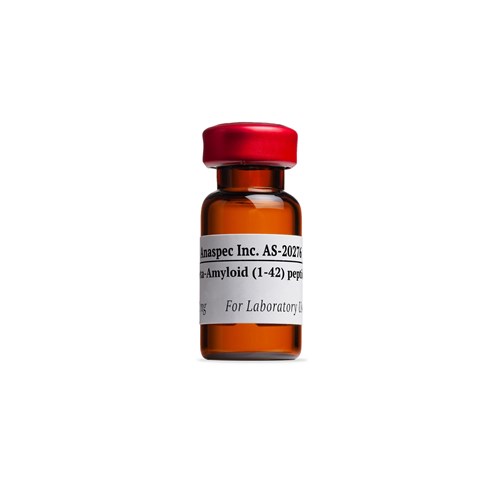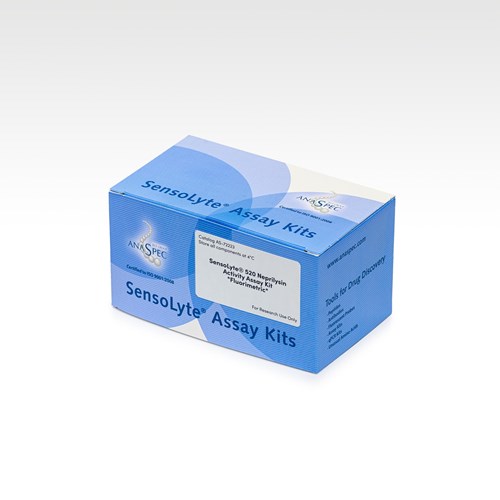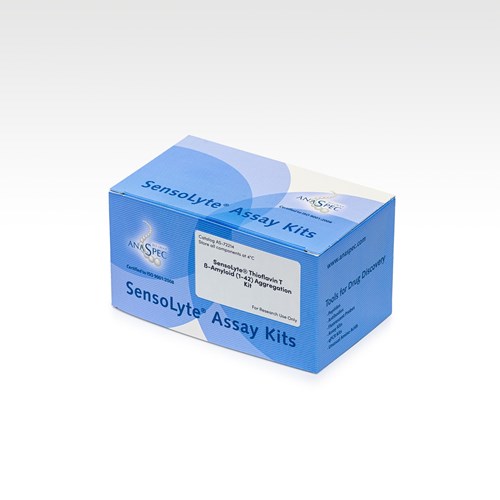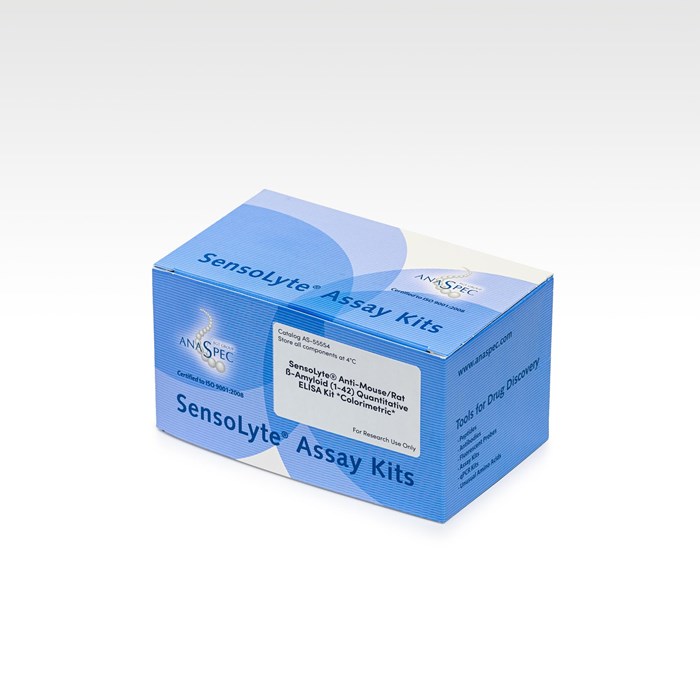SensoLyte® Anti-Mouse/Rat ß-Amyloid (1-42) Quantitative ELISA Kit Colorimetric - 1 kit
- Cat.Number : AS-55554
- Manufacturer Ref. :
-
Availability :
In stock
- Shipping conditions : Ice fees will apply
Alternative choices
This SensoLyte® high-sensitivity (2pg/ml) beta-Amyloid (1-42) Quantitative ELISA Kit (Mouse/Rat) provides a convenient and quantitative assay for determining mouse/rat beta-Amyloid (1-42) (Aβ42) amount in cell and tissue lysate as well as in body fluids. Compared to other mouse/rat anti-Aβ42 ELISA kits on the market, it takes less time to run this assay. HRP conjugated detection antibody in this kit is added simultaneously with the samples and standards during the assay. This eliminates extra incubation and washing steps and makes this kit a one-step procedure for Aβ42 quantification.
Alzheimer's Disease (AD) is the most common neurodegenerative disorder in elderly people. It has been demonstrated that AD has biological causes and is characterized by the presence of senile plaques and neurofibrillary tangles mainly in cerebral cortex and hippocampus brain regions. Beta-Amyloid (1-40) (Aβ40) and beta-Amyloid (1-42) (Aβ42) are the main components of the above plaques; however, other forms of beta-Amyloid peptides are also present. Both peptides are cleaved from the Amyloid Precursor Protein (APP) by β-secretase and γ-secretase enzymes. Many studies suggest that Aβ42 or/and Aβ43 are required to initiate formation of amyloid plaques and neurofibrills that leads to the neurodegeneration, while Aβ40 is less neurotoxic.
Specifications
| Packaging | |
| Kits components |
|
|---|---|
| Chemistry | |
| UniProt number |
|
| Storage & stability | |
| Storage Conditions |
|
| Activity | |
| Application | |
| Biomarker Target | |
| Detection Method | |
| Detection Limit |
|
| Research Area | |
| Sub-category Research Area | |
| Usage |
|
| Source | |
| Source / Species |
|
Downloads
You may also be interested in the following product(s)


SensoLyte® 520 Neprilysin Activity Assay Kit Fluorimetric - 1 kit

SensoLyte® Thioflavin T ß-Amyloid (1-42) Aggregation Kit - 1 kit
Citations
Synaptic and cognitive improvements by inhibition of 2-AG metabolism are through upregulation of microRNA-188-3p in a mouse model of Alzheimer's Disease.
J Neurosci . 2014 Nov 05 ; 34 14919 | DOI : 10.1523/JNEUROSCI.1165-14.2014.
- J. Zhang
Isoform-specific hyperactivation of calpain-2 occurs presymptomatically at the synapse in Alzheimer’s disease mice and correlates with memory deficits in human subjects
Sci Rep . 2018 Sep 03 ; 8 13119 | DOI : https://doi.org/10.1038/s41598-018-31073-6
- F. Ahmad
- et al
Vildagliptin: an anti-diabetes agent ameliorates cognitive deficits and pathology observed in streptozotocin-induced Alzheimer's disease
J Pharmacy and Pharmacol . 2013 Dec 01 ; 65(12) 1773 | DOI : https://doi.org/10.1111/jphp.12148
- J. Kosaraju
- et al
Saxagliptin: A dipeptidyl peptidase-4 inhibitor ameliorates streptozotocin induced Alzheimer’s disease
Neuropharmacol . 2013 Sep 01 ; 72 291
- J. Kosaraju
- et al
References
Animal Models of Alzheimer's Disease. Neuronal Models for Studying Tau Pathology
Intl J Alzheimer’s Dis . 2010 Jul 18 ; 2010 528474 | DOI : https://doi.org/10.4061/2010/528474
- T. Koechling
- et al
Anti-Aβ42– and anti-Aβ40–specific mAbs attenuate amyloid deposition in an Alzheimer disease mouse model
J Clin Invest . 2006 Jan 04 ; 116(1) 193 | DOI : 10.1172/JCI25410
- Y. Levites
- et al
APP processing in Alzheimer's disease
Mol Brain . 2011 Jan 07 ; 4 1 | DOI : https://doi.org/10.1186/1756-6606-4-3
- Y-W. Zhang
- et al
The culprit behind amyloid beta peptide related neurotoxicity in Alzheimer's disease: oligomer size or conformation?
Alzheimer’s Res Therapy . 2010 Jul 14 ; 2(12) 1 | DOI : https://doi.org/10.1186/alzrt36
- K. Broersen
- et al
Saliva levels of Abeta1-42 as potential biomarker of Alzheimer's disease: a pilot study
BMC Neurol . 2010 Nov 03 ; 10(108) | DOI : https://doi.org/10.1186/1471-2377-10-108
- F. Bermejo-Pareja
- et al

